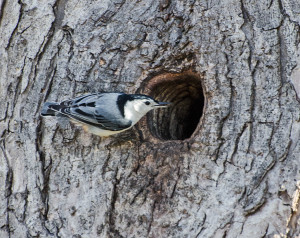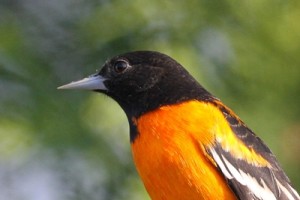The morning chorus of spring begins quite early in the day. I’ve heard robins singing at 4:30 a.m.!
A songbird or oscine is a bird belonging to the suborder Passeri of Passeriformes, in which the vocal organ developed in such a way as to produce various sounds that we commonly refer to as bird song. Interestingly, many of the birds that belong to this classification do not have a song that we would consider melodic. Take the nuthatch, for example. The repetitive “wic, wic, wic, wic” may not sound like a song to us, but it certainly does the trick or we wouldn’t have been watching a young nuthatch being fed by parents on our bird walks. What about the simple song of the chickadee – “fee-be” or “fee-be-bay”? Not a very long or complex song, yet chickadees are classified as songbirds.
Birds sing first and foremost to express territory ownership. With his song, a resident male alerts other males of the same species that the territory is taken. Secondly, the song is meant to attract a female of the same species so that the male can carry on his genes. After mating has taken place, the males’ song acts as a pair bond, letting the female know that her mate is within their territory.
From a birdwatcher’s perspective, song has a different meaning. The complex, burbling, and constant song of the house wren lets us know that he has returned, ready to claim the nest boxes that have been set out for use. The various songs of warblers alert us that they have safely arrived this far in their migration. As foliage becomes thicker, songs alert us as to which birds to look for if we are out and about with binoculars.
There are many songbirds that can be attracted to feeders including goldfinches, house finches, cardinals, chickadees, jays and nuthatches. Then there are other songbirds that are attracted to feeders that many people do not prefer including red-winged blackbirds, cowbirds, and common grackles. There are also some premier songbirds that we wish we could attract to feeders such as the wood thrush and veery; alas, they are not attracted to anything but insects.
To poets and writers, song birds are the subject of much writing. Clarence Hawkes wrote about the common grackle –
“The grackles are here and that is quite clear.
The morning is ringing, – not with their singing,
But with their talking, they’re piping and squawking . . .”
On a brighter note, John Proctor Mills wrote –
“There’s a song on each swiging bough –
Of the forest green with spring,
There’s a golden note from the Oriole’s throat –
That the whispering zephyrs bring.”
How ironic that each of these birds are part of the same family of birds, the Icteridae, making them related even though their songs are so dissimilar.
Whatever a songbird means to you, this is the season for listening. The earlier in the day the better, to take advantage of the possibilities that are open to us. To heighten the experience, close your eyes while you are sitting in your yard and key in on your sense of sound. You’ll be amazed at what you might hear this time of year.
Enjoy your birds!
Have you joined our email list? Click here to sign up, it’s free and gives you access to sales, coupons, nature news, events, and more!



